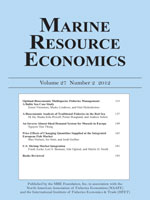Recent supply shocks in the Gulf of Mexico—including hurricanes, the Deepwater Horizon oil spill, and the seasonal appearance of a large dead zone of low oxygen water (hypoxia)—have raised concerns about the economic viability of the U.S. shrimp fishery. The ability of U.S. shrimpers to mediate supply shocks through increased prices hinges on the degree of market integration, both among shrimp of different sizes classes and between U.S. wild caught shrimp and imported farmed shrimp. We use detailed data on shrimp prices by size class and import prices to conduct a co-integration analysis of market integration in the shrimp industry. We find significant evidence of market integration, suggesting that the law of one price holds for this industry. Hence, in the face of a supply shocks, prices do not rise; instead, imports of foreign farmed fish increase.
JEL Classification Code: Q22





